Evaluating Rainwater Harvesting Systems for Water Scarcity Mitigation in Small Greek Islands under Climate Change
Abstract
:1. Introduction
2. Materials and Methods
2.1. Study Areas and Datasets
2.2. Daily Water Balance Simulation and Scenarios
3. Results and Discussion
3.1. Initial Simulation
3.2. Climate Change Scenarios Investigation
4. Conclusions
Author Contributions
Funding
Institutional Review Board Statement
Informed Consent Statement
Data Availability Statement
Acknowledgments
Conflicts of Interest
References
- Bates, B.; Kundzewicz, Z.; Wu, S.; Palutikof, J. Observed and projected changes in climate as they relate to water. In Climate Change and Water; Intergovernmental Panel on Climate Change: Geneva, Switzerland, 2008; pp. 13–31. [Google Scholar]
- Farreny, R.; Gabarrell Durany, X.; Rieradevall, J. Cost-Efficiency of Rainwater Harvesting Strategies in Dense Mediterranean Neighbourhoods. Resour. Conserv. Recycl. 2011, 55, 686–694. [Google Scholar] [CrossRef]
- Shadmehri Toosi, A.; Danesh, S.; Ghasemi Tousi, E.; Doulabian, S. Annual and Seasonal Reliability of Urban Rainwater Harvesting System under Climate Change. Sustain. Cities Soc. 2020, 63, 102427. [Google Scholar] [CrossRef]
- Campisano, A.; D’Amico, G.; Modica, C. Water Saving and Cost Analysis of Large-Scale Implementation of Domestic Rain Water Harvesting in Minor Mediterranean Islands. Water 2017, 9, 916. [Google Scholar] [CrossRef]
- Förster, J. Variability of Roof Runoff Quality. Water Sci. Technol. 1999, 39, 137–144. [Google Scholar] [CrossRef]
- Göbel, P.; Dierkes, C.; Coldewey, W.G. Storm Water Runoff Concentration Matrix for Urban Areas. J. Contam. Hydrol. 2007, 91, 26–42. [Google Scholar] [CrossRef] [PubMed]
- Villarreal, E.L.; Dixon, A. Analysis of a Rainwater Collection System for Domestic Water Supply in Ringdansen, Norrköping, Sweden. Build. Environ. 2005, 40, 1174–1184. [Google Scholar] [CrossRef]
- Panigrahi, B.; Panda, S.N.; Mal, B.C. Rainwater Conservation and Recycling by Optimal Size On-Farm Reservoir. Resour. Conserv. Recycl. 2007, 50, 459–474. [Google Scholar] [CrossRef]
- Ghisi, E.; Bressan, D.L.; Martini, M. Rainwater Tank Capacity and Potential for Potable Water Savings by Using Rainwater in the Residential Sector of Southeastern Brazil. Build. Environ. 2007, 42, 1654–1666. [Google Scholar] [CrossRef]
- Guo, Y.; Baetz, B.W. Sizing of Rainwater Storage Units for Green Building Applications. J. Hydrol. Eng. 2007, 12, 197–205. [Google Scholar] [CrossRef]
- Liaw, C.-H.; Tsai, Y.-L. Optimum Storage Volume of Rooftop Rain Water Harvesting Systems for Domestic Use1. JAWRA J. Am. Water Resour. Assoc. 2004, 40, 901–912. [Google Scholar] [CrossRef]
- Handia, L.; Tembo, J.M.; Mwiindwa, C. Potential of Rainwater Harvesting in Urban Zambia. Phys. Chem. Earth Parts A/B/C 2003, 28, 893–896. [Google Scholar] [CrossRef]
- Ward, S.; Memon, F.A.; Butler, D. Performance of a Large Building Rainwater Harvesting System. Water Res. 2012, 46, 5127–5134. [Google Scholar] [CrossRef] [PubMed]
- Campisano, A.; Modica, C. Optimal Sizing of Storage Tanks for Domestic Rainwater Harvesting in Sicily. Resour. Conserv. Recycl. 2012, 63, 9–16. [Google Scholar] [CrossRef]
- Tsihrintzis, V.A.; Baltas, E. Determination of rainwater harvesting tank size. Glob. Nest. J. 2014, 16, 822–831. [Google Scholar]
- Ghisi, E.; Tavares, D.d.F.; Rocha, V.L. Rainwater Harvesting in Petrol Stations in Brasília: Potential for Potable Water Savings and Investment Feasibility Analysis. Resour. Conserv. Recycl. 2009, 54, 79–85. [Google Scholar] [CrossRef]
- Londra, P.A.; Theocharis, A.T.; Baltas, E.; Tsihrintzis, V.A. Optimal Sizing of Rainwater Harvesting Tanks for Domestic Use in Greece. Water Resour Manag. 2015, 29, 4357–4377. [Google Scholar] [CrossRef]
- Basinger, M.; Montalto, F.; Lall, U. A Rainwater Harvesting System Reliability Model Based on Nonparametric Stochastic Rainfall Generator. J. Hydrol. 2010, 392, 105–118. [Google Scholar] [CrossRef]
- The Hellenic Climate Atlas by HNMS. Available online: http://climatlas.hnms.gr/sdi/ (accessed on 12 February 2024).
- Monthly Bulletins by NOANN. Available online: https://www.meteo.gr/Monthly_Bulletins.cfm (accessed on 12 February 2024).
- Hellenic Statistical Authority Datasets. Available online: https://www.statistics.gr/ (accessed on 12 March 2024).
- Lagouvardos, K.; Kotroni, V.; Bezes, A.; Koletsis, I.; Kopania, T.; Lykoudis, S.; Mazarakis, N.; Papagiannaki, K.; Vougioukas, S. The Automatic Weather Stations NOANN Network of the National Observatory of Athens: Operation and Database. Geosci. Data J. 2017, 4, 4–16. [Google Scholar] [CrossRef]
- Data Extraction Application for Regional Climate (DEAR-Clima); Web Application Tool. Available online: http://meteo3.geo.auth.gr:3838/ (accessed on 12 February 2024).
- Tsikerdekis, A.; Myriounis, C.; Zanis, P.; Tsirogiannis, I. Climate change and its impact on annual maximum precipitation using high resolution regional climate simulations for the region of Igoumenitsa. In Proceedings of the XXXIIème Colloque Internationale de l’AIC, Thessaloniki, Greece, 29 May–1 June 2019. [Google Scholar]
- Wisner, P.; P’ng, J.C. OTTHYMO, A Model for Master Drainage Plans. In IMPSWM Urban Drainage Modelling Procedures, 2nd ed.; Department of Civil Engineering, University of Ottawa: Ottawa, ON, Canada, 1983. [Google Scholar]
- Kinkade-Levario, H. Design for Water Rainwater Harvesting, Stormwater Catchment and Alternate Water Reuse; New Society Publishers: Gabriola Island, BC, Canada, 2007; p. 38. [Google Scholar]
- Thornton, R.C.; Saul, A.J. Some quality characteristics of combined sewer flows. J. Public Health Eng. 1986, 14, 35–38. [Google Scholar]
- Yaziz, M.I.; Gunting, H.; Sapari, N.; Ghazali, A.W. Variations in Rainwater Quality from Roof Catchments. Water Res. 1989, 23, 761–765. [Google Scholar] [CrossRef]
- Coombes, P. Rainwater Tanks Revisited: New Opportunities for Urban Water Cycle Management. Ph.D. Thesis, University of Newcastle, Newcastle, NSW, Australia, 2002. [Google Scholar]
- Jones, M.; Hunt, V.F.; Wright, J. Rainwater harvesting experiences in the humid south-east USA. In Proceedings of the World Environment and Water Resources Congress, Kansas City, MO, USA, 17–21 May 2009. [Google Scholar]
- Jones, M.P.; Hunt, W.F. Performance of rainwater harvesting systems in the southeastern United States. Resour. Conserv. Recycl. 2010, 54, 623–629. [Google Scholar] [CrossRef]
- Zhang, Y.; Grant, A.; Sharma, A.; Chen, D.; Chen, L. Alternative water resources for rural residential development in Western Australia. Water Resour. Manag. 2010, 24, 25–36. [Google Scholar] [CrossRef]
- Liuzzo, L.; Notaro, V.; Freni, G. A Reliability Analysis of a Rainfall Harvesting System in Southern Italy. Water 2016, 8, 18. [Google Scholar] [CrossRef]
- Fewkes, A.; Butler, D. Simulating the Performance of Rainwater Collection and Reuse Systems Using Behavioural Models. Build. Serv. Eng. Res. Technol. 2000, 21, 99–106. [Google Scholar] [CrossRef]
- Londra, P.A.; Gkolfinopoulou, P.; Mponou, A.; Theocharis, A.T. Effect of Rainfall Regime on Rainwater Harvesting Tank Sizing for Greenhouse Irrigation Use. Hydrology 2022, 9, 122. [Google Scholar] [CrossRef]
- Koumoura, K.; Feloni, E.; Londra, P.; Baltas, E.; Tsihrintzis, V. Uncertainty Analysis in Sizing Rainwater Harvesting Tanks in an Isolated Island with Limited Water Resources. Glob. Nest J. 2018, 20, 534–540. [Google Scholar] [CrossRef]
- Reitano, R. Water Harvesting and Water Collection Systems in Mediterranean Area. The Case of Malta. Procedia Eng. 2011, 21, 81–88. [Google Scholar] [CrossRef]
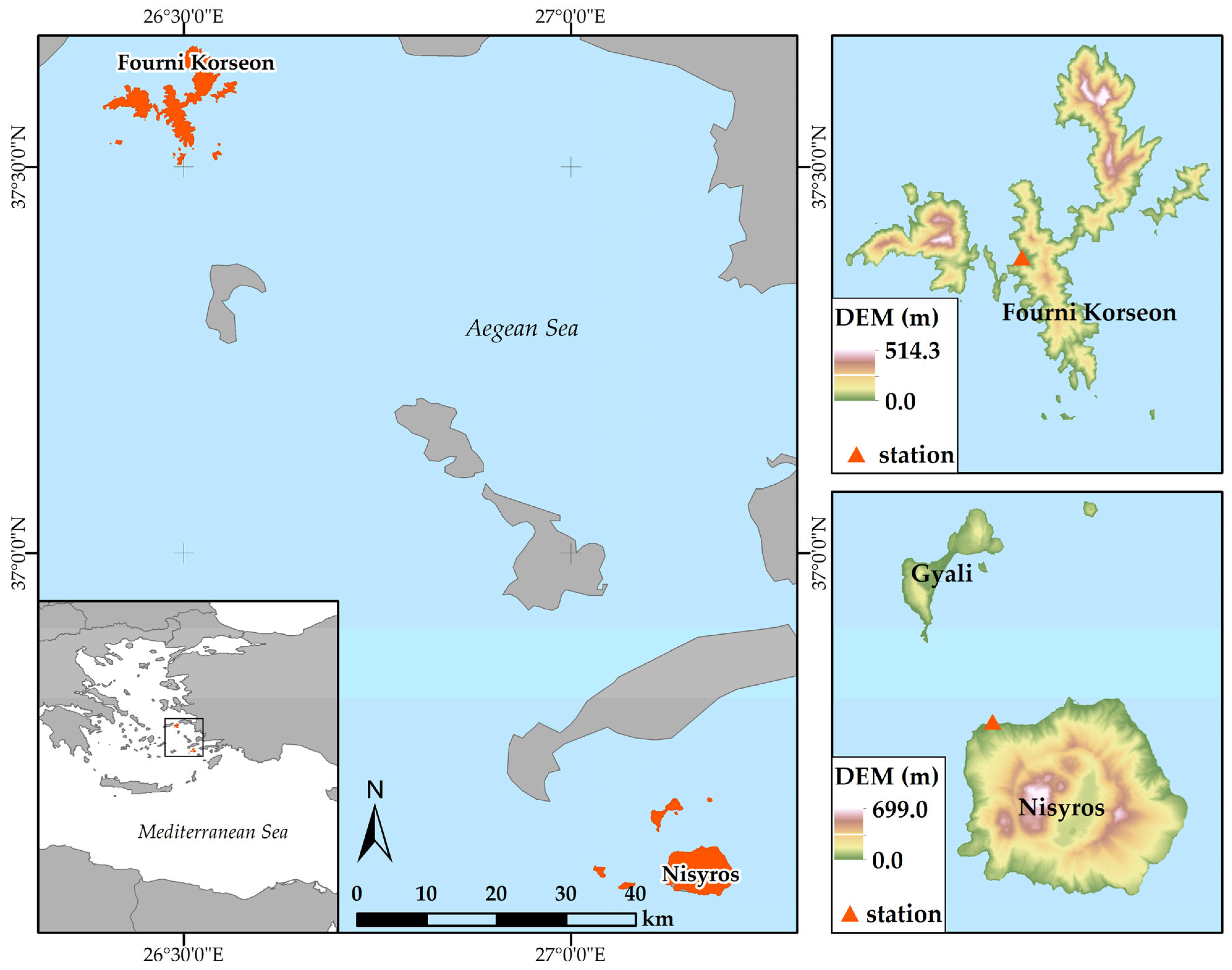
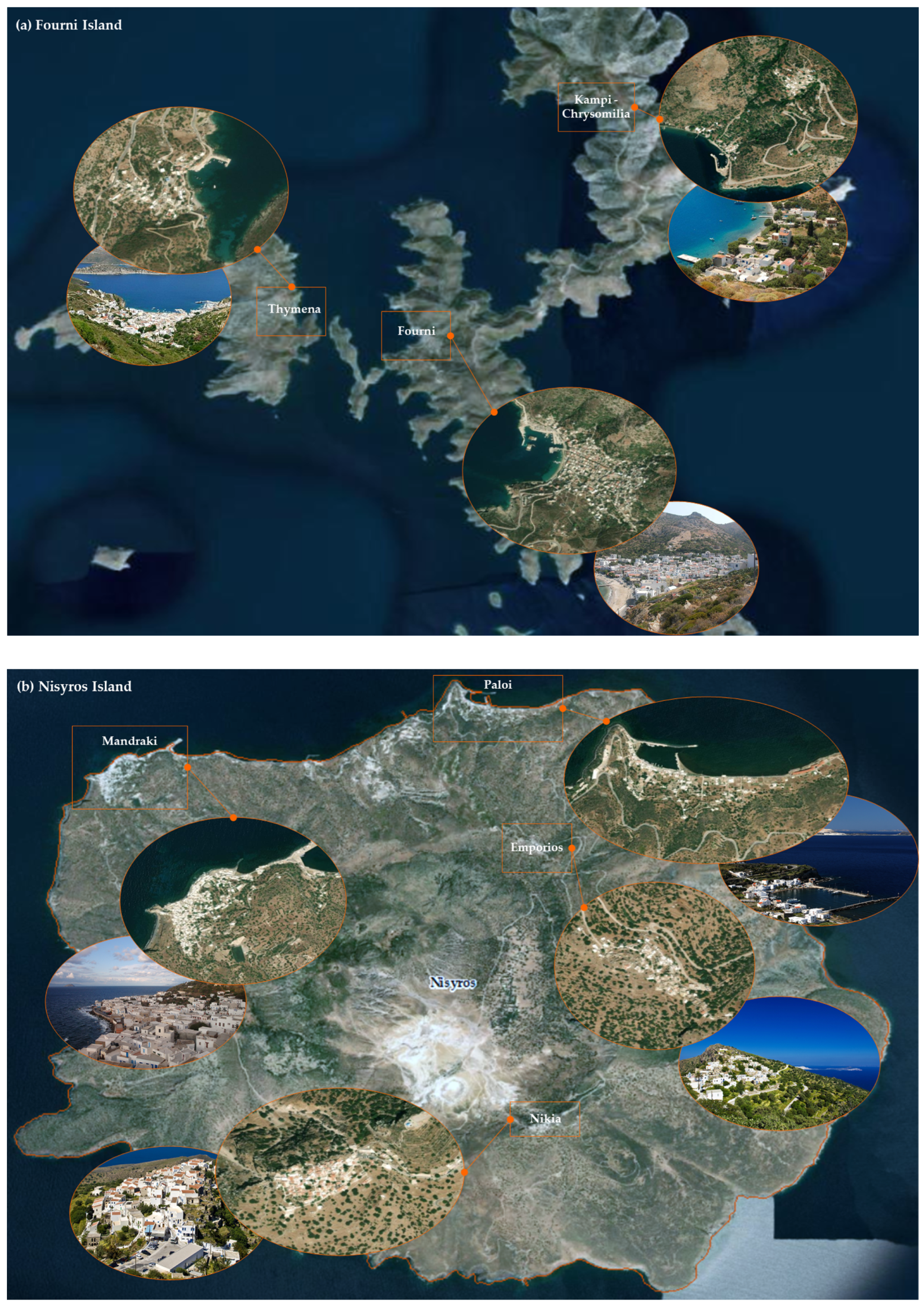

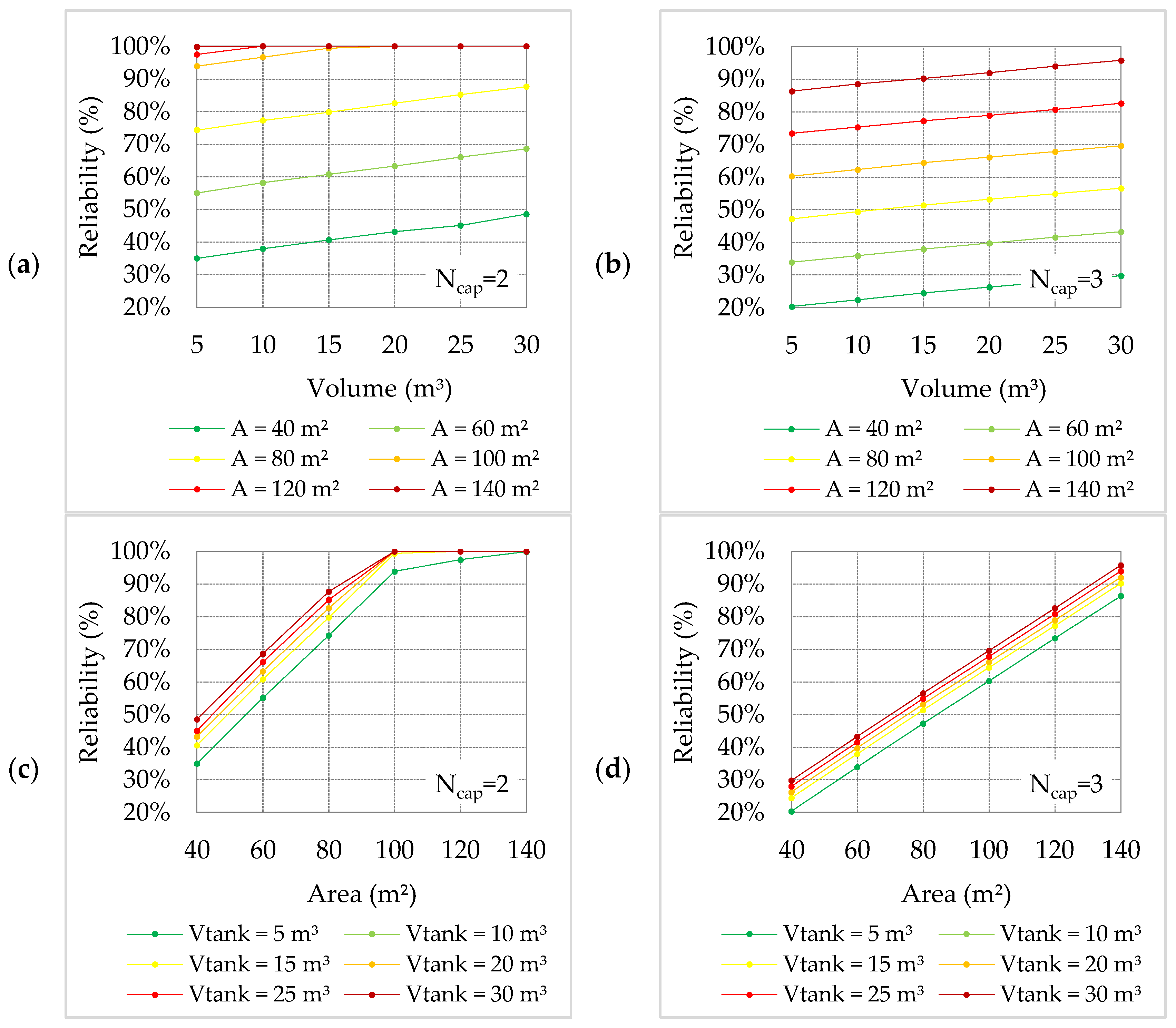
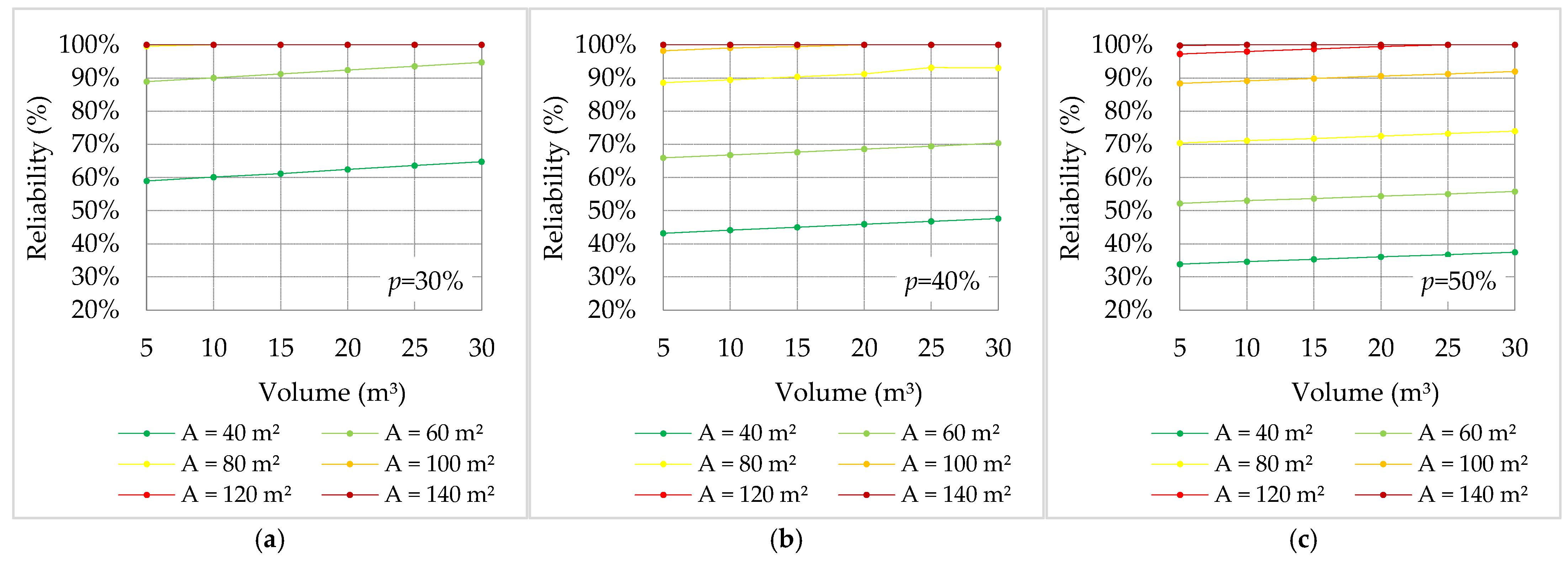
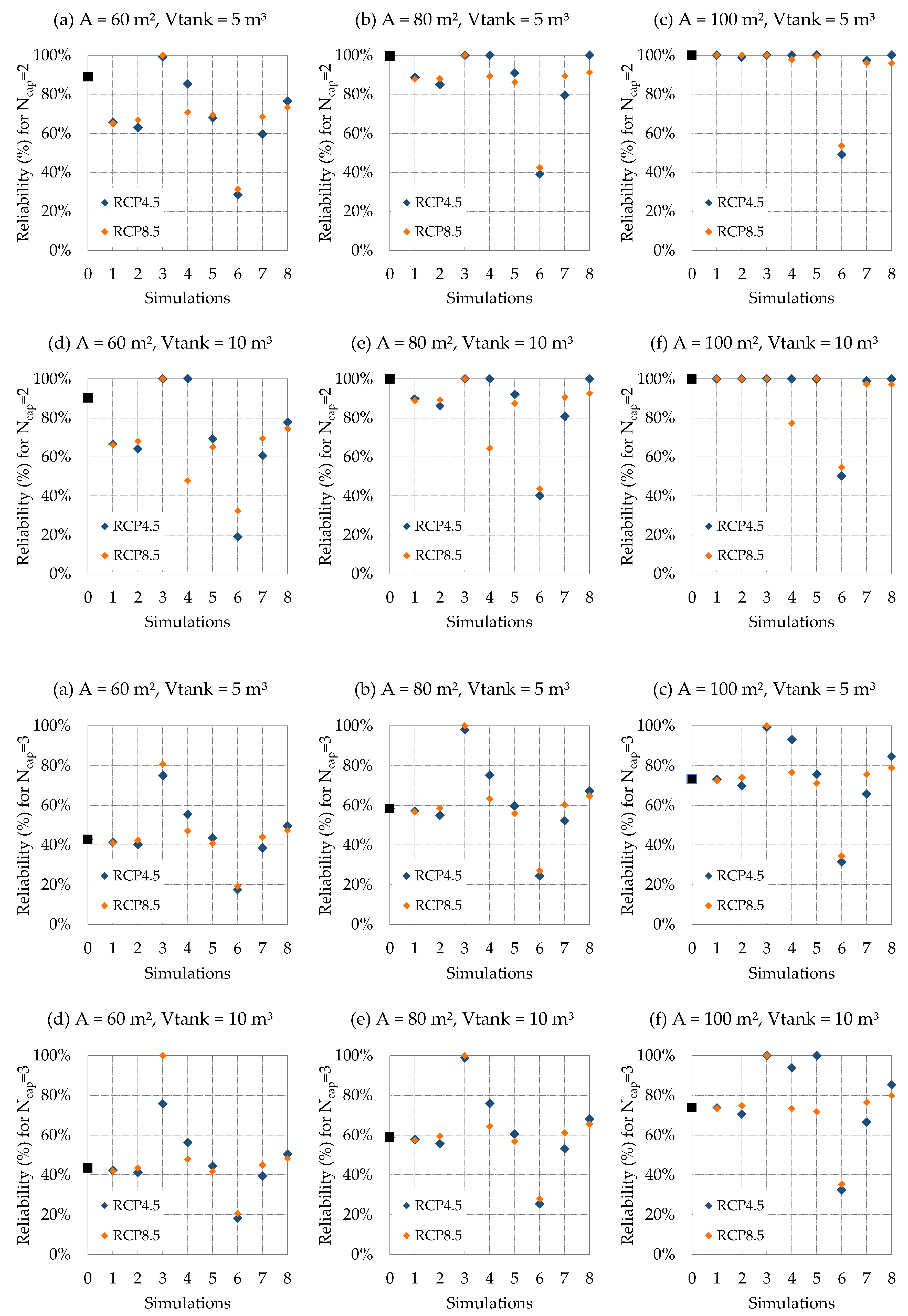
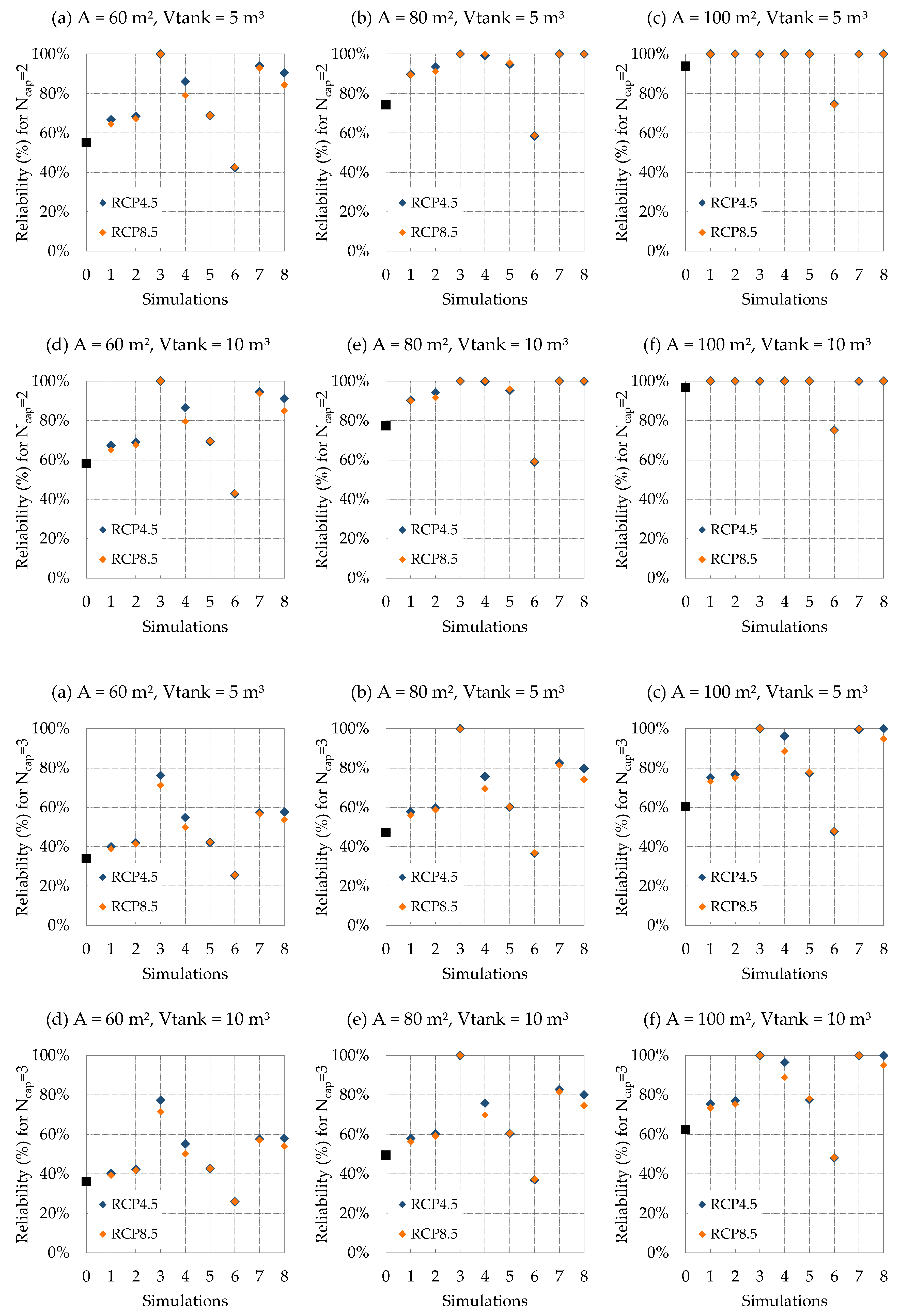
| ID | RCM | GCM |
|---|---|---|
| 1 | CLMcom-CCLM4-8-17 | CNRM-CERFACS-CNRM-CM5 |
| 2 | CLMcom-CCLM4-8-17 | MPI-M-MPI-ESM-LR |
| 3 | IPSL-INERIS-WRF331F | IPSL-IPSL-CM5A-MR |
| 4 | KNMI-RACMO22E | ICHEC-EC-EARTH |
| 5 | SMHI-RCA4 | CNRM-CERFACS-CNRM-CM5 |
| 6 | SMHI-RCA4 | IPSL-IPSL-CM5A-MR |
| 7 | SMHI-RCA4 | MOHC-HadGEM2-ES |
| 8 | CLMcom-CCLM4-8-17 | MOHC-HadGEM2-ES |
Disclaimer/Publisher’s Note: The statements, opinions and data contained in all publications are solely those of the individual author(s) and contributor(s) and not of MDPI and/or the editor(s). MDPI and/or the editor(s) disclaim responsibility for any injury to people or property resulting from any ideas, methods, instructions or products referred to in the content. |
© 2024 by the authors. Licensee MDPI, Basel, Switzerland. This article is an open access article distributed under the terms and conditions of the Creative Commons Attribution (CC BY) license (https://creativecommons.org/licenses/by/4.0/).
Share and Cite
Feloni, E.; Nastos, P.T. Evaluating Rainwater Harvesting Systems for Water Scarcity Mitigation in Small Greek Islands under Climate Change. Sustainability 2024, 16, 2592. https://doi.org/10.3390/su16062592
Feloni E, Nastos PT. Evaluating Rainwater Harvesting Systems for Water Scarcity Mitigation in Small Greek Islands under Climate Change. Sustainability. 2024; 16(6):2592. https://doi.org/10.3390/su16062592
Chicago/Turabian StyleFeloni, Elissavet, and Panagiotis T. Nastos. 2024. "Evaluating Rainwater Harvesting Systems for Water Scarcity Mitigation in Small Greek Islands under Climate Change" Sustainability 16, no. 6: 2592. https://doi.org/10.3390/su16062592






